Shep Hyken's Blog, page 162
September 6, 2017
Big Mistake… Don’t Judge a Book By Its Cover
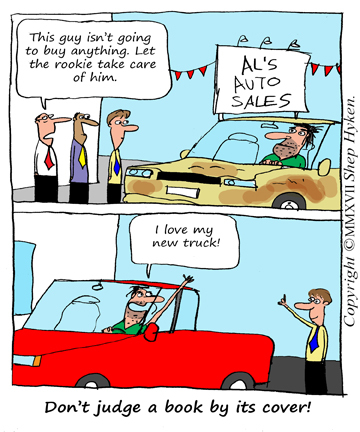 There’s an old proverb that says, “Outward appearances are not a reliable indication of true character.” In other words, you can’t – and shouldn’t – judge a book by its cover.
There’s an old proverb that says, “Outward appearances are not a reliable indication of true character.” In other words, you can’t – and shouldn’t – judge a book by its cover.
One of my favorite examples of this is from the movie Pretty Woman starring Julia Roberts and Richard Gere. This classic movie from back in the 1990’s was about a wealthy man, Edward Lewis, on a business trip in Beverly Hills who falls in love with a prostitute, Vivian Ward. Edward wants Vivian to attend some of his business functions throughout the week, so he gives her some money (as in thousands of dollars) to buy some conservative, less revealing, clothes. In her “working clothes” Vivian walks into an upscale store where the employees won’t sell her anything and asks her to leave. Dejected, she returns to the hotel. The next day, the hotel manager takes her to a different store and gets her outfitted in some beautiful clothes. As she is walking back to the hotel, dressed in one of her new outfits and carrying several bags with different Beverly Hills store logos on them, she stops back into the store that asked her to leave. She asked the salesperson if she remembers her from yesterday. She reminds her, and then comes the famous line from the movie: “Big mistake. Big. Huge! I have to go shopping now.”
I experienced something similar years ago when I was looking to buy a new car. I was just 22 years old and driving an older car that had 170,000 miles on it. I’m not exaggerating! I walked into the dealership and none of the sales people would talk to me. I knew it was the car. They saw me drive up in an old car and decided I didn’t have the money to buy a new car.
The next day I went back, but this time in my father’s car, which was quite nice. This time I was approached by numerous salespeople. I had no trouble finding a sales person who wanted to sell me a car. I shared the story with the manager of the dealership, who was quite embarrassed. As a way of apologizing, he sold me a car at a fantastic price.
In business, it can be economically dangerous to make a snap judgement based on someone’s looks, what they are wearing, the car they drive and more. The founder of Walmart, Sam Walton, used to drive a pick-up truck. He didn’t look like a man who was worth billions of dollars. How many times did he “fool” people with his unassuming looks. It wasn’t intentional. It was just who he was.
Unless they prove otherwise, customers should be treated like… customers. Don’t make the mistake of judging a book by its cover. As Vivian Ward said in Pretty Woman, “Big mistake. Big. Huge!”
Shep Hyken is a customer service expert, keynote speaker and New York Times bestselling business author. For information contact or www.hyken.com. For information on The Customer Focus™ customer service training programs go to www.thecustomerfocus.com. Follow on Twitter: @Hyken
(Copyright © MMXVII, Shep Hyken)
The post Big Mistake… Don’t Judge a Book By Its Cover appeared first on Shep Hyken.
September 5, 2017
Amazing Business Radio: Matt Peterson
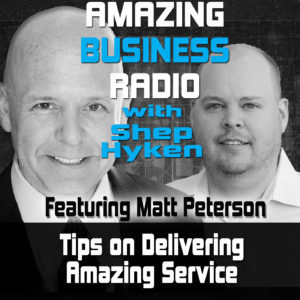
Matt Peterson Shares Tips on Delivering Amazing Service
How would you like to know how to set yourself apart from the rest of your industry?
Shep Hyken interviews Matt Peterson, CMO and co-founder of Jive Communications, a worldwide cloud based communication company that offers VoIP, video conferencing, and contact center support.
Featured Interview:
Shep begins the interview by talking to Matt about NPS (Net Promoter Score) and he made that an important focus in his company. Matt explains why he feels NPS is the right method for his company, and how it helped Jive elevate their service above the rest of their industry.
Top Takeaways:
Measure your customer satisfaction. Matt knows the important of measurement, especially in the area of service and satisfaction. He also emphasizes how important it is to make a satisfaction score an important part of the company’s culture and mentality.
Don’t automate customer care. There are certain things that you can automate but you shouldn’t dehumanize the experience. You should use automated intelligence properly and allow for a smooth natural transition to a human when the automated support can no longer handle the issue properly.
Communicate the way your customers want to communicate. You don’t need to be everywhere, but you need to know where and how your customers want to communicate with you, whether it’s via social media, email, chat, etc. Customers should be able to communicate with you however is most convenient and comfortable.
Get out of the “Ivory Tower.” You need to stay connected to your customers, so get out there meet with them. Get their opinions and feedback. You won’t be able to do that if you never leave your office.
About:
Matt Peterson is Co-founder and CMO of Jive Communications, one of the highest-rated communications companies. Matt is responsible for designing the marketing strategies and processes that drive Jive’s growth, it’s obvious he cares about his customers.
Shep Hyken is a customer service and experience expert , “New York Times” best-selling author, and your host of Amazing Business Radio.
“Everyone (at Jive) is a customer service agent. If you see a problem it is your responsibility to fix it.” – Matt Peterson
This episode of Amazing Business Radio with Shep Hyken answers the following questions … and more:
How can I use Net Promotor Score (NPS) to increase my customer satisfaction?
How can I improve my customer loyalty?
What can I do to create better customer service?
How can NPS help my business?
How can I set myself apart from my competition?
The post Amazing Business Radio: Matt Peterson appeared first on Shep Hyken.
September 4, 2017
5 Top Customer Service Articles for the Week of September 4, 2017
Each week I read a number of customer service and experience articles from various online resources. Here are my top five picks from last week. I have added my comment about each article and would like to hear what you think too.
The top five things you hate most about customer service by Sarah Ingrams
(Which?) Whether you’re buying new gadgets, planning a holiday or managing your finances, everyone has to deal with customer service from time to time. An outstanding experience can persuade you to keep returning to a brand; being treated badly can put you off for life
My Comment: Want to now what your customers hate more than anything (when it comes to customer service)? Then read this article featuring five of the top “irritations” that customers in any business might experience.
When The CMO Owns Customer Experience: 10 Top CMOs Share Their POV by Blake Morgan
(Forbes) I talked with 10 top CMOs from a number of industries to get their insights into the changing role of the CMO, how they build relationships with customers, how they stay on top of changes in today’s omnichannel world, and more.
My Comment: Blake Morgan has given us a gift. She took the time to interview ten CMO’s from some large and recognizable brands in a number of industries who share what customer experience means to them. No doubt that CX is a very, very high priority!
Technology NPS Benchmarks by CustomerGauge
(CustomerGauge) There are a hundreds of technology innovations clamouring for customer’s attention, yet only a few are dominating customers’ loyalty.
My Comment: The CustomerGauge people continue to put out amazing content related to NPS (Net Promoter Score). This article highlights some major brands within the technology industry (including Apple) and shares a big lesson (or two or three). One of the big takeaways is that the leaders close the loop on feedback within 48 hours, which according to CustomerGauge, leads to a 12% increase in customer retention.
10 Insights from Customer Care Experts & Influencers by CGS
(CGS Inc.) Did you miss some of these great insights recently tweeted by customer care influencers and experts? We rounded up 10 great tips and insights from some of the best experts in the industry to help you stay on top of important topics and trends.
My Comment: CGS has compiled a list of experts and influencers in the customer care and CX world – with links to some of their work. There is something here for everyone. Great advice from some of the best in the business!
Why Visual Support is the Future of Customer Service by Robert C. Johnson
(B2Community) Companies are always trying to be on the cutting edge when it comes to customer service. Not only is it a competitive advantage for your business development team, it also is a great way to keep current customers happy. One of the leading trends in customer service is a much stronger emphasis on visual support methods.
My Comment: This short article is about using visuals like screen sharing and video to support customers. I love using video as a way to deliver a great self-service customer support solution. The best videos are “how to” videos that teach customers how to best use your products and services.
BONUS
101 Customer Service Quotes To Better Your Business by Skip Prichard
(Skip Prichard) Here are a collection of customer service quotes all designed to remind us of the importance of the customer.
My Comment: My friend Skip Prichard put together a list of 101 customer service quotes. I’m honored and proud that Skip included several of mine for the list. Consider using these quotes as conversation starters at your team meetings. Great information. Thanks Skip!
Shep Hyken is a customer service expert, professional speaker and New York Times bestselling business author. For information contact or www.hyken.com . For information on The Customer Focus™ customer service training programs go to www.thecustomerfocus.com . Follow on Twitter: @Hyken
The post 5 Top Customer Service Articles for the Week of September 4, 2017 appeared first on Shep Hyken.
September 1, 2017
Guest Blog: Don’t Make Me Wait
This week we feature an article by Andy Ko who writes about not making your customers wait to have their questions answered. Self-service support is becoming more and more widely accepted. Not just accepted, in some cases it is preferred. – Shep Hyken
As both a professor and chief scientist at a SaaS software company, I spend time around two groups of people that couldn’t be more different:
Enterprise marketing, sales, and customer experience executives
Nineteen year-old college students
The first group loses sleep over rising costs, whereas the second just loses sleep.
But these two groups have more in common than you think:
Both have highly fragmented time.
Both spend more time on their smartphone than they’d like to admit.
Both are constantly searching for new applications that will save them time.
When they have high-friction experiences with an app, they quickly abandon it for something more usable.
This last point is key: the moment your customer gets stuck and frustrated, there’s bound to be a newer more polished competitor they’re itching to switch to. Millennials or executives alike, both are screaming at your business “don’t make me wait!”
How Can You Stop A Customer From Bailing?
First, recognize that answers have to be instant. The moment a customer has a question, they need an answer. And if they don’t see a way to get an answer right where they are, they’re going to search the web and either fail to find their answer or, worse yet, end up on a competitor’s site. In fact, 57% of users abandon a site if they can’t find an answer.
When I Say Instant, I Mean Instant
Don’t be fooled by the promise of traditional self-service solutions like knowledge bases and static FAQs. Both are “help islands” and they don’t work. They require your customers to interrupt their task, find the tiny help link on your site, know exactly the right words to search for, and—if they’ve made it this far—read an article completely out of context for their task and somehow find their way back to where they were. If you look closely at your knowledge base traffic, don’t be surprised to find out that fewer than 1% of your customers ever reach your knowledge base, let alone find content it in. All of that hard work at creating content is moot if no one finds it.
There Are Better Ways
Contextual self-service — the idea of placing knowledge base content directly on every screen of your application—is the future. Many customer self-service companies are offering this basic functionality now, basically placing a search box behind a floating tab or help button. These can work better, but only if you use the right words in your content: if you title your help article “How to update your security credentials” and your customer is searching for “password change”, they’re not going to find your answer. The problem is, finding the right words for every article can be extremely costly and training your customers to know the right words is downright impossible.
With predictive Q&A and self-service customer support you can overcome these terminology problems in multiple ways:
You can use predictive analytics to determine the most likely relevant questions. As soon as a customer accesses the contextual Q&A space, one of the top popular questions is probably the question they have.
It allows customers to browse Q&A in-context. This allows them to just recognize the relevant questions, rather than having to choose words to represent their question.
It allows customers to click or tap the content they have a question about using object related search technology. This allows them to just point to express their question.
 Because these technologies are so good at instantly finding the content a customer needs, most customers never need to search.
Because these technologies are so good at instantly finding the content a customer needs, most customers never need to search.
Don’t make your customers wait! Consider adopting a contextual self-service software solution today and watch your support tickets drop and your sales increase.
Andy Ko is the Chief Scientist and Co-Founder at AnswerDash, a B2B software company that facilitates customer service for e-commerce businesses. He is also a Professor at the University of Washington.
For more articles from Shep Hyken and his guest contributors go to customerserviceblog.com.
Read Shep’s latest Forbes Article: Are Your Customers Cheating On You?
The post Guest Blog: Don’t Make Me Wait appeared first on Shep Hyken.
August 30, 2017
The Power of a Personal Handwritten Note
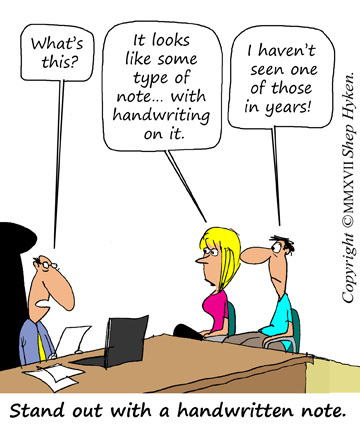 There is a lot of power in a handwritten, personal note. This isn’t just about a thank you note to a customer, although those are important as well. This is also about the note of appreciation to someone who has done a great job or hit their goals. You get the idea. Anything you might want to congratulate them on.
There is a lot of power in a handwritten, personal note. This isn’t just about a thank you note to a customer, although those are important as well. This is also about the note of appreciation to someone who has done a great job or hit their goals. You get the idea. Anything you might want to congratulate them on.
Ted Janusz is one of our amazing trainers at Shepard Presentations. He was conducting a half-day customer service workshop, and during a break, the client, who happened to be the president of the company, walked up to Ted and congratulated him on doing a great job. He mentioned how impressed he was that Ted had done his homework to truly learn about the company, their issues and their objectives. Of course, Ted was flattered and very appreciative of the kind words.
Two hours later, when the program was finished, the president of the company wrapped up the day, again congratulating Ted on job well done. But there was more.
As Ted was leaving the president handed Ted an envelope. No, it wasn’t the check for the presentation. It was a personal handwritten note, again expressing his appreciation for a job well done and the obvious work that he put into personalizing it for his company. Ted couldn’t wait to share it with us. He was so proud of the note, and who wouldn’t be?
When was the last time you received an accolade from your boss, a colleague at work, or even a customer? How did it make you feel? Some people who get notes from people they work with save them, because they are special. They have impact.
Years ago, I wrote about my client and friend, Glenn Brown, who at the time was CEO of Contract Freighters, Inc. (CFI), a trucking company. He had a stack of cards and was using them to write notes to employees who deserved accolades or had a birthday or anniversary. He mentioned to me that he tries to write a short note to his employees who don’t get to see him at the office at least twice a year. He said, “It lets them know I appreciate them, even though we never see each other.” Many of CFI’s employees are truck drivers that seldom, if ever, make it into the office. Glenn knew how to make them feel good about working at CFI.
Sure, there are other ways to show appreciation. Verbal praise, an email, a small gift, an appreciation lunch for employees and more. All of those are great signs of appreciation, and I’m not suggesting giving up any of those. However, after seeing how much Ted appreciated the note from our client, which made me think back to Glenn Brown, I believe the handwritten note takes a gesture of appreciation to the next level.
Shep Hyken is a customer service expert, keynote speaker and New York Times bestselling business author. For information contact or www.hyken.com. For information on The Customer Focus™ customer service training programs go to www.thecustomerfocus.com. Follow on Twitter: @Hyken
(Copyright © MMXVII, Shep Hyken)
The post The Power of a Personal Handwritten Note appeared first on Shep Hyken.
August 29, 2017
Amazing Business Radio: Nick Francis
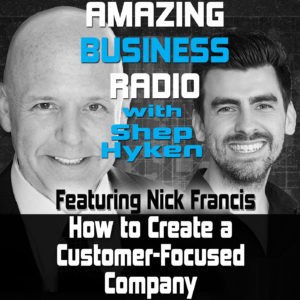
Nick Francis Shares How to Create a Customer-Centric Company
How would you like to increase customer loyalty?
Shep Hyken interviews Nick Francis, CEO of Help Scout and thought leader in the customer service support world.
First Up:
Shep Hyken’s opening comments focus on introducing Nick Francis and his company Help Scout, and the recent fireside chat they had at a recent customer service and support conference.
Featured Interview:
Shep begins the interview by asking Nick Francis about Help Scout, which provides customer support assistance to small businesses. They discuss how important customer service is to your business and why it’s vital to set yourself apart from your competition. After all, word-of-mouth is by far the best advertising you can get. Nick shares his tactical steps to creating a better customer experience. They discuss the importance of customer trust and how to regain it if it’s lost.
Top Takeaways:
Tactical Steps to Improve Your Customer Service
Create a customer service vision – or as Shep calls it, a customer service mantra. This is a vital step for anyone who wants a customer-focused organization.
Make it easy for your customer – don’t just make it easy for the customer to find you and contact you but make it easier by providing different methods of contact. Nick suggests focusing on only a couple of channels to start until you master those, then expand to the channels where your customers are.
Don’t just collect data – do something with it! You not only need to get customer feedback, you need to do something with it. Eliminate pain points for customers, create a list of FAQs. Leverage the customer feedback – Pay attention to both the qualitative and quantitative data, as these will help with ensuring adequate staff and by preventing potential customer complaints from being repeated.
Ensure your interactions are human. Be empathetic and most importantly be authentic when speaking with your customers.
Trust is key – Don’t make anything about you. Make it about the customer. If you make a mistake own it, and then do everything you can to regain their trust. Nobody’s perfect – mistakes are bound to happen. It’s how you handle them that counts.
Content is important to any business. It enhances the customer experience. Help Scout has a customer service blog they post at least twice a week.
About:
Nick Francis is Co-founder and CEO of Help Scout, where he is on a mission to make every customer service interaction a more human one. Nick lives and breathes product design, customer experience, and building a thoughtful, thriving company.
Shep Hyken is a customer service and experience expert , “New York Times” best-selling author, and your host of Amazing Business Radio.
“It starts with the mantra (a customer service vision). In the end, it’s not about the tools, the techniques or the tactics; it really is about that mantra, if you want to have a customer-centric business.” – Nick Francis
This episode of Amazing Business Radio with Shep Hyken answers the following questions … and more:
How can I create customer loyalty?
How can I create a better customer experience?
How should I handle a customer complaint?
What is the best marketing?
How do I regain customer trust?
How do I build a customer centric organization?
The post Amazing Business Radio: Nick Francis appeared first on Shep Hyken.
August 28, 2017
5 Top Customer Service Articles for the Week of August 28, 2017
Each week I read a number of customer service and experience articles from various online resources. Here are my top five picks from last week. I have added my comment about each article and would like to hear what you think too.
The Contact Center Playbook for Improving Customer Satisfaction [Whitepaper] by Nicolina Savelli
(Fonolo) In this handy playbook, contact center leaders will learn the ins and outs of improving customer satisfaction, otherwise known as CSat. This guide will discuss important metrics to consider when measuring satisfaction, and how to achieve customer happiness and retention along the way.
My Comment: Don’t skip this article if you’re not in the contact center world. While the article’s title appears to be focused on contact and support centers, the concepts can be used by any type of business in any industry. Ideas like understanding industry benchmarks and using feedback are for everyone. This is a great article from my friends at Fonolo!
Artificial Intelligence: The Customer Experience Imperative by Bob Hayes
(Business Over Broadway) The tools and methods of artificial intelligence, machine learning and predictive analytics will play a major role in helping businesses better understand and manage the customer experience.
My Comment: This is a very short article, but still has some really good information about the basics of how AI (Artificial Intelligence) can enhance customer service.
Cost-effective service excellence by Jochen Wirtz & Valarie Zeithaml
(Springer) This article integrates relevant literature to develop a conceptual model on the potential avenues to achieve service excellence at low unit costs, which we term cost-effective service excellence (CESE).
My Comment: This is more than an article. This is a major research paper on the topic of low cost, but effective, customer service. There is plenty of information here to digest. The authors are academics and they have gone to great lengths to share important information related to the customer service industry. Taking the time to read this is like attending a high-level graduate course.
Customer Service Hall of Fame and Customer Service Hall of Shame by Samuel Stebbins, Michael B. Sauter and Evan Comen
(24/7 Wall St.) One of the most important aspects of doing business for almost any company is customer service. In order to develop a loyal customer base and thrive, companies often need to go above and beyond customer expectations. While nearly every major U.S. company claims to prioritize customer needs, only a few are able to do so successfully.
My Comment: Each year “24/7 Wall Street” shares their list of the best and worst customer service companies. They teamed up with Zogby Analytics to bring you the companies they believe belong in the customer service “Hall of Fame” and the “Hall of Shame.” I don’t think you’ll find any surprises in the companies representing the bottom of the customer service world, however you may be surprised at a few of the Hall of Famers. (Well deserved, I might add!)
The Future of Customer Loyalty Programs – Now and for the Holidays by Timi Garai
(Antavo) Online eCommerce giants are moving into the offline sphere and we’re seeing more and more innovative solutions based on Big Data.
My Comment: If you’re in retail (and even if you’re not), you’ll definitely want to read this article. And while the article makes reference to the holiday season, many of these ideas work year round. I’m most intrigued by the statement, “What works for Amazon can work for other retailers… Every company can have their Amazon moment.”
Shep Hyken is a customer service expert, professional speaker and New York Times bestselling business author. For information contact or www.hyken.com . For information on The Customer Focus™ customer service training programs go to www.thecustomerfocus.com . Follow on Twitter: @Hyken
The post 5 Top Customer Service Articles for the Week of August 28, 2017 appeared first on Shep Hyken.
August 25, 2017
Guest Blog: The Do’s and Dont’s of Using Chatbots for Customer Service
This week we feature an article by Reuben Yonatan who writes about how using chatbots for customer service properly can be a powerful customer service tool. Chatbots can be great for handling basic customer support functions, communicating with customers when a rep isn’t available and more. – Shep Hyken
Many small businesses are looking for ways to streamline communication. They know customers want fast, accurate information as soon as they need it. According to some reports, 41% of customers expect a business to answer an email in just six hours. But, only 36% can respond that fast. Social media is even more demanding on businesses. Today’s consumer wants to find a business’s Twitter, Facebook, or Instagram page, type a question and receive a knowledgeable response nearly right away.
Is your business able to pay someone to do this and keep up with the demand?
It’s a Challenge That Chatbots Aim to Take On
A chatbot is an important tech tool available to most businesses. Its goal is to help speed up a company’s ability to provide important information to consumers. They work much like a messaging app in that a person types a question and the software goes to work to answer it. They use data from what the customer is saying to personalize the interaction. Because they can mine significant amounts of data in moments, chatbots can be very powerful.
More so, some reports indicate chatbots are money-saving tools companies can’t overlook. They could reduce your customer service costs by as much as 30%, according to some providers.
Are Chatbots Really an Ideal Solution for Customer Service?
A chatbot has limitations like all technology does. What’s most important in any customer service interaction is providing your customer with exactly what they need and providing personalized service. No matter what the situation, you need to foster a sense of support and caring to ensure your customer comes back to you.
Provide Quality Service First
Bots are not a solution to poor customer service. If your organization is struggling to provide quality service due to your policies, product, or service, putting a chatbot in place cannot resolve the problem. It could be part of the solution, though.
People Still Want and Expect Humans
Chatbots can be a good solution to most needs, but they cannot (and should not) replace the human that’s available when questions are complex or a consumer’s need is not met. Don’t forget the human component of your business.
Implement These Best Practices for Chatbot Use in Your Business
Chatbots offer benefits:
They cut down on the amount of labor you are paying to answer phones.
They can tackle most questions immediately.
They speed up customer service in most cases.
Chatbots do offer drawbacks:
Simply, they are not human.
They have limited ability in some situations.
They can frustrate customers when the software isn’t ideal.
How do you find a balance? You put in place some specific best practices to help ensure your customers are getting the quality service they need without the frustration that’s often behind it.
#1: Make it easy to use and reliable.
Be sure your customers’ expectations are always met with chatbots. There’s no sense in trying to “hide” them, but you do need to focus on creating an easy-to-use interface.
Use the message format. It’s what customers already know how to use.
Keep the software up to date to avoid glitches.
Test and test it again! Be sure it’s working exactly how you want it to.
#2: Make it as natural as possible.
When creating your chatbot, it’s essential to ensure a chatbot feels comfortable to use.
Keep it in a conversational tone. It’s important for it to use language your customers recognize and use daily.
Use some expressive, emotive aspects to help ensure the conversation seems personal. A smiley face here or there works well!
Incorporate “common” language. Contractions are good! Exclamation points can work well for positive situations.
#3: Ensure your chatbot aligns with your brand.
View a chatbot as an extension of your brand — it’s the first interaction many consumers will have with your company!
Use language that fits your brand. Incorporate phrases you use in your marketing material.
Use your brand’s colors.
Implement graphics that fit your company.
Use images of your employees (if they approve).
#4: Make navigation simplistic.
Using a chatbot should not disconnect the user from your website. You want them to go back to sign up or buy from you.
Link back to the main page within the chat window.
Incorporate links in the responses from the chatbot to pages of your site that provide actionable steps for the user, such as a page to order a product.
Add an information button in the format to give users the ability to read an FAQ.
#5: Keep responses short.
People online do not read blocks of information. They want answers quickly and easily.
Provide short answers to questions.
Instead of a detailed description, link to the answer on your website.
Keep messages to less than 63 characters (or about two lines).
For mobile, no more than three lines of text will work well.
#6: Use multiple devices to test functionality.
Your messages look different from one device to the next.
Check online access via your website.
Determine if changes to your mobile format are needed (i.e. spacing, layout, or links).
If your chatbot links to or through Facebook, make sure the format works well.
Test and test again!
#7: Let them pay you!
A common request of chatbots is the need to pay a bill or buy a service. Make it simplistic!
Incorporate a “pay now” link into the chatbot that leads to the direct payment page.
Don’t redirect too much. Provide the most direct route to making a purchase.
Tell them it’s a secure link to a payment portal.
#8: Give them options.
Consumers are more likely to respond if you give them specific steps to take, but give them options along the way.
List the answer, then offer a secondary option.
Instead of saying “this is your answer” say, “let’s consider the options” and provide multiple choices.
Provide links to answers, but give them more than one. Keep the user in control.
#9: Always keep it thankful.
Again, this is an extension of your brand. The skills you teach your customer service reps need to happen here.
When they arrive, use their name followed by, “How is your day going?”
Incorporate thank you in a sincere way. Say, “I’m glad you asked me that.”
Thank them for talking to you.
When Not to Use Chatbots for Customer Service
Recognize when using chatbots aren’t the best option. Don’t use them in situations your customers may think are emergencies, such as disputing a claim or getting medical advice. You also always want to ensure there’s some level of background support available. Don’t use them as the only tool for your company, in other words.
When used well, chatbots can be a powerful customer service tool. However, it’s important to customize them to fit your business’s image, brand, and customer service goals. Remember, they are not a cure for bad customer service, but they can amplify your good service practices and help reduce your customer service costs significantly.
Reuben Yonatan is the founder and CEO of GetVoIP and GetCRM — trusted VoIP and CRM comparison guides that help companies understand and choose a business communication solution for their specific needs. With a 10-year track record in building, growing and strategically shaping operational functionality in all his ventures, Reuben assists SMBs align business strategy with culture and improve overall corporate infrastructure.
For more articles from Shep Hyken and his guest contributors go to customerserviceblog.com.
Read Shep’s latest Forbes Article: How To Humanize Customer Service For B2B Organizations
The post Guest Blog: The Do’s and Dont’s of Using Chatbots for Customer Service appeared first on Shep Hyken.
August 23, 2017
Pay Attention! Don’t Just Go Through the Motions!
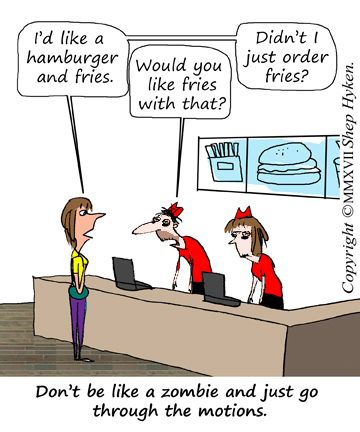 A friend of mine went to the airport rental car agency and had a chance to upgrade to a Tesla. He had never driven a Tesla so he was happy to pay the upcharge to have the experience. If you’ve ever rented a car at the airport, you typically are stopped at a gated exit where the car rental employee looks over the paperwork, checks your driver’s license and sends you on your way. One of the questions they will typically ask is, “Would you like the fuel option?” That allows you the convenience of paying for a tank of gas so you don’t have to worry about filling before returning the car.
A friend of mine went to the airport rental car agency and had a chance to upgrade to a Tesla. He had never driven a Tesla so he was happy to pay the upcharge to have the experience. If you’ve ever rented a car at the airport, you typically are stopped at a gated exit where the car rental employee looks over the paperwork, checks your driver’s license and sends you on your way. One of the questions they will typically ask is, “Would you like the fuel option?” That allows you the convenience of paying for a tank of gas so you don’t have to worry about filling before returning the car.
At the gate, the attendant went through the typical routine and then asked the routine question, “Would you like the fuel option?”
My friend thought was funny and started laughing. A Tesla is an electric car. No fuel necessary to run this amazing four-wheeled piece of technology. The attendant wasn’t sure what was funny, then he realized what he’d asked and was embarrassed.
A similar experience happened to me at McDonald’s. I just love those fries! It was quite some time ago, but I’ll never forget the day I ordered a chicken sandwich with fries. After I told the nice woman behind the counter what I wanted, she asked me, “Would you like fries with that?”
My response was, “Do you mean another order of fries, or did you mean to ask me if I’d like a hot apple pie with that chicken sandwich and fries?” I smiled at her. At first, she blushed with embarrassment and then laughed. And, by the way, I added the apple pie to my order, which I love almost as much as the fries.
And, that is what brings us to the point. Both the gate attendant at the rental car agency and my new friend at McDonalds were just going through the motions. This is easy to do when it’s late in the day and fatigue is setting in. But, the best people stay alert and focused. They recognize that their customers are unique individuals and do their best to give them the unique experience they deserve.
One way to avoid the “just going through the motions” syndrome is to individualize each interaction you have with a customer. After you greet the customer come up with something specific to say to them. For example, a customer in a store might be wearing a baseball hat from their favorite team. Break the ice by making a comment about the team. Or, perhaps you’re talking with someone on the phone. Ask her where she is calling from. The goal is to break the monotony of the routine. That creates a unique conversation with each customer, allowing you to stay away from routine and monotony.
Every interaction you have counts. Never make a customer feel as if they are anything less than special and unique.
Shep Hyken is a customer service expert, keynote speaker and New York Times bestselling business author. For information contact or www.hyken.com. For information on The Customer Focus™ customer service training programs go to www.thecustomerfocus.com. Follow on Twitter: @Hyken
(Copyright © MMXVII, Shep Hyken)
The post Pay Attention! Don’t Just Go Through the Motions! appeared first on Shep Hyken.
August 22, 2017
Amazing Business Radio: Nicky Billou
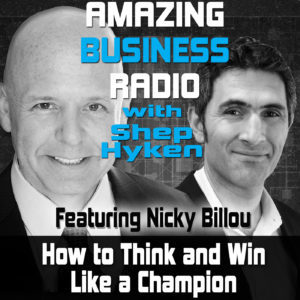
Nicky Billou on How to Think and Win Like a Champion
How would you like to know how to build your own personal brand to become a thought leader in your industry?
Shep Hyken interviews Nicky Billou, internationally best-selling author of Finish Line Thinking: How to Think and Win Like a Champion.
First Up:
Shep Hyken’s opening comments focus on how thought leadership applies to everyone. He explains how managers and individuals can be thought of as an expert in their company and industry. This ties into Shep’s concept that when it comes to customer service, everyone can be a leader.
Featured Interview:
Shep begins the interview by asking Nicky Billou about his definition of a thought leader and how everyone could be considered the “go-to” person or expert in their company. Shep then introduces why getting your customers and coworkers to trust you is an important part of building your personal brand and for being known as an expert. They discuss how everyone has an opportunity to be considered a thought leader by knowing the answers; or if you don’t know, knowing where to find the answers.
Top Takeaways:
Anyone can be a thought leader. Thought leadership is not just for authors or speakers, everyone can be known for their expertise within their area of genius – especially in customer service and support.
Create champions. – As a manager, you need to find those champions and nurture them to become the experts you know they can be. You can help bring out the best in your people.
The Four Phases of being a thought leader.
Wannabe Phase – This person has not yet figured out what their expertise is.
Unconscious Expert – They intuitively know they have some level of expertise, but they aren’t quite clear on it yet.
Conscious Expert – You know you have expertise and you are actively applying it.
Known – This is the final stage where you are known as an expert/thought leader.
Build your personal brand. – You need to find your area of expertise and create a LinkedIn profile. Everyone has a brand – you should consciously create your own brand.
Your customers are the only people who can tell you what your brand is. You not only need to create your own brand you need to also ensure what your customer’s perception of you is. At any given time, anybody in your organization that is dependent upon you for anything is also your customer.
About:
Nicky Billou is Cofounder of eCircle Academy, Cohost of The Business of Thought Leadership Podcast, and #1 International Best-selling Author of Finish Line Thinking: How To Think & Win Like A Champion.
Shep Hyken is a customer service and experience expert , “New York Times” best-selling author, and your host of Amazing Business Radio.
“People have to trust you, and trust that what you have to say is meaningful and relevant and helps them with the problems they need help with.” – Nicky Billou
This episode of Amazing Business Radio with Shep Hyken answers the following questions … and more:
How can I become a thought leader?
How can I build my personal brand?
Who can be considered a thought leader?
How can I win like a champion?
The post Amazing Business Radio: Nicky Billou appeared first on Shep Hyken.








